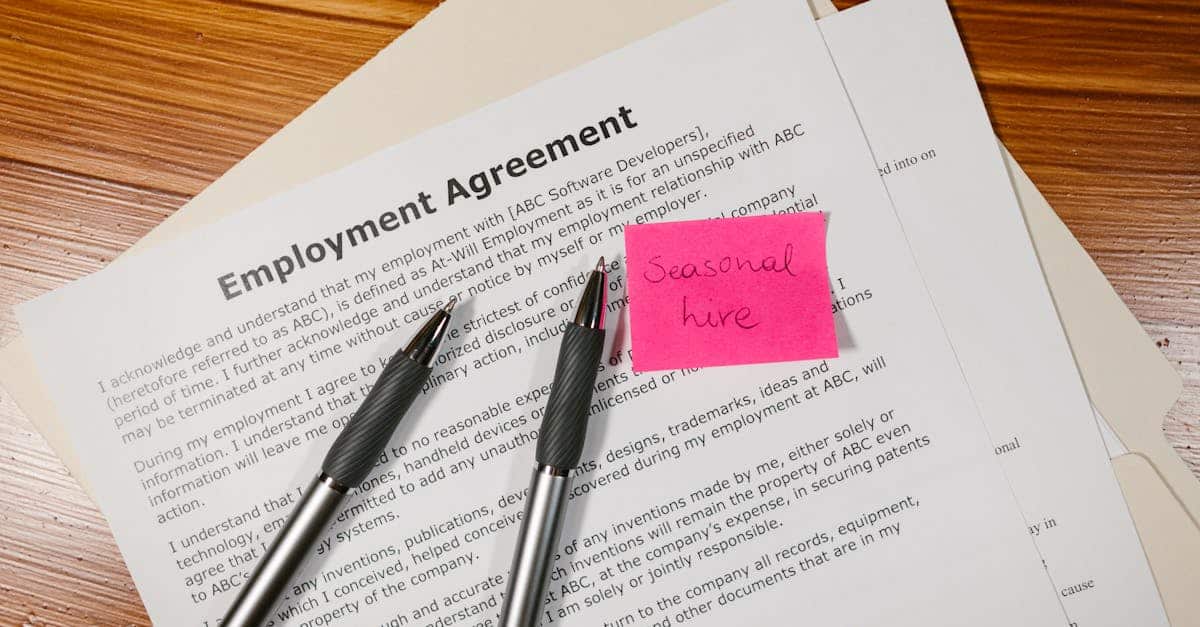
The Best Document Automation Tools for HR Compliance in 2025: Top Features & Template Picks
1. Introduction
The year 2025 brings with it a complex and ever-shifting landscape for HR compliance. With new regulations continuously emerging, particularly around data privacy, remote work, and employee rights, HR departments in growing businesses face an unprecedented administrative burden. The challenge of ensuring every document aligns with the latest legal standards, while managing an increasing volume of paperwork, is no longer sustainable through traditional, manual processes.
This is where the right document automation tools become indispensable. Designed to transform laborious, error-prone tasks into efficient, streamlined operations, these solutions are revolutionizing how HR navigates compliance. This article will guide you through the top features to look for and highlight practical template picks, helping you equip your HR team with the best tools to reduce risk, save time, and foster a truly compliant and productive workplace.
2. Overview: Evolving HR compliance landscape in 2025
The HR compliance landscape is in constant flux, and 2025 presents its own set of challenges and opportunities. With new regulations emerging regularly, particularly around data privacy, remote work, and employee rights, HR departments face an escalating burden of administrative tasks. Ensuring every document aligns with the latest legal standards is a colossal undertaking for any growing business.
This is where **legal automation** steps in, transforming what was once a manual, error-prone process into an efficient, streamlined operation. The traditional approach, often involving stacks of paper or disparate digital files, is simply not sustainable given the pace of legislative change and the demand for rapid, accurate compliance. Companies are increasingly looking at sophisticated **legal software** solutions to navigate these complexities, reduce risk, and free up valuable HR time for strategic initiatives rather than repetitive paperwork.
3. Why HR managers need document automation tools
For HR managers, the sheer volume of documentation required for compliance can be overwhelming. From onboarding new hires to managing performance reviews and handling terminations, each step demands specific, legally sound documents. Manual processes are not only time-consuming but also prone to costly errors that can lead to significant legal exposure.
Key Benefits of Document Automation for HR:
- Enhanced Accuracy: Automated templates reduce human error, ensuring consistency and adherence to legal requirements across all documents.
- Time Savings: What once took hours can now be completed in minutes, allowing HR professionals to focus on more strategic, people-centric tasks. This efficiency is a core advantage of **legal automation systems**.
- Cost Reduction: Minimizing errors and streamlining workflows directly translates to fewer legal challenges and operational overhead.
- Improved Compliance: Keeping up with ever-changing regulations becomes far more manageable when document templates are centrally managed and automatically updated. This is a critical aspect of **document automation software**.
- Better Employee Experience: A smooth, paperless process for new hires or employee requests creates a positive impression and reduces frustration.
Tools that offer robust **document automation** capabilities are no longer a luxury but a necessity for modern HR departments aiming for optimal efficiency and compliance.
4. Core features to look for in HR document automation software
When evaluating **legal automation software** for your HR needs, certain core features are non-negotiable for maximizing efficiency and compliance. The right tool should seamlessly integrate into your existing workflows and provide a comprehensive solution for document management.
Essential Features:
- Template Management: The ability to create, store, and easily customize a library of legal document templates is fundamental. This ensures consistency and legal compliance.
- Automated Data Population: Look for software that can automatically pull employee data from your HRIS or other systems to populate forms, eliminating manual data entry.
- E-Signature Integration: Secure, legally binding electronic signature capabilities are crucial for streamlining approvals and agreements.
- Version Control & Audit Trails: Robust tracking of document versions and a clear audit trail of all changes ensure transparency and accountability.
- Workflow Automation: Features that allow you to define and automate document routing for approvals, reviews, and signatures significantly boost productivity.
- Integration Capabilities: The software should integrate with your existing HR systems, payroll platforms, and other business tools to create a unified ecosystem.
- Reporting & Analytics: The ability to generate reports on document status, completion rates, and compliance metrics provides valuable insights for continuous improvement.
These features collectively empower HR teams to adopt a proactive approach to compliance, moving away from reactive firefighting.
5. Scenarios where automation streamlines HR compliance (onboarding, terminations, payroll, etc.)
Legal automation provides significant advantages across various critical HR scenarios, ensuring compliance and efficiency where it’s needed most. These are not just theoretical benefits; they translate into tangible improvements in daily operations.
Practical Applications:
- Onboarding: Automating the creation and distribution of offer letters, employment agreements, confidentiality agreements, and new hire paperwork vastly speeds up the onboarding process. This ensures every new employee receives the correct, legally compliant documents promptly. For example, consider leveraging a comprehensive solution like the Employment Agreement Set to standardize your hiring documents.
- Performance Management: Generating performance appraisal letters, warning notices, and disciplinary action forms can be complex. Automation ensures consistent language and adherence to company policy and legal requirements. Tools like the Performance Appraisal Letter Set can streamline this sensitive area.
- Terminations: The termination process requires meticulous documentation to mitigate legal risks. Automated generation of termination letters, severance agreements, and final pay notices ensures accuracy and compliance with labor laws. Explore the Termination of Employment Letter Set for a robust solution.
- Payroll & Benefits: While not direct document creation, automation can assist in generating and tracking compliance forms related to benefits enrollment, tax documents, and compensation adjustments, ensuring all necessary acknowledgments and consents are captured.
- Policy Acknowledgments: Distributing and tracking employee acknowledgments for company policies, codes of conduct, and handbooks is simplified with automated workflows and e-signatures.
By applying **automation tools** to these areas, HR teams can significantly reduce administrative burden and focus on fostering a positive workplace culture, rather than being bogged down by paperwork. This also aligns with the principles seen in **law firm case management software**, where efficiency and meticulous documentation are paramount.
6. Actionable Formtify template sets for HR compliance
Formtify offers a practical solution to many common HR documentation challenges through its pre-designed template sets. These sets are built to facilitate quick and compliant document generation, helping HR managers to implement **legal automation** effectively without starting from scratch.
Highlighted Formtify Template Sets for HR:
- Employment Agreement Set: Kickstart your hiring process with legally sound documents. This set, available at https://formtify.app/set/employment-agreement-mdok9, provides comprehensive templates for employment contracts, ensuring clarity on terms, conditions, and responsibilities from day one.
- Termination of Employment Letter Set: Navigating employee separations requires precision and compliance to avoid legal pitfalls. The templates in this set, found at https://formtify.app/set/termination-of-employment-letter-eyvtl, help you generate accurate and legally compliant termination letters, severance agreements, and related documents.
- Performance Appraisal Letter Set: Effective performance management is crucial for employee development and retention. This set, accessible at https://formtify.app/set/performance-appraisal-letter-6xd8y, provides structured templates for performance reviews, goal setting, and feedback, ensuring a consistent and fair process.
These curated sets are examples of how focused **document automation** can immediately alleviate administrative burdens, providing ready-to-use solutions that integrate seamlessly into your HR compliance strategy. This approach is reminiscent of the tailored solutions provided by **lawmatics** in a legal context, bringing specialized efficiency to HR operations.
7. Tips for seamless implementation and adoption
Implementing new **legal automation systems** within your HR department requires a thoughtful approach to ensure smooth transition and high user adoption. It’s not just about installing software; it’s about integrating a new way of working.
Key Strategies for Success:
- Start Small, Scale Up: Begin with one or two key processes that offer high impact, such as onboarding documents or performance reviews. This allows your team to get comfortable with the **automation tools** before rolling out more extensive applications.
- Involve Your Team: Engage HR staff early in the selection and implementation process. Their insights are invaluable, and their buy-in is crucial for successful adoption. Consider creating an internal “legal automation specialist” role or champion.
- Provide Comprehensive Training: Offer clear, hands-on training sessions. Explain not just *how* to use the software but *why* it will benefit their daily work, emphasizing time savings and reduced stress from compliance worries.
- Communicate Benefits Clearly: Continuously highlight how the **legal software** reduces manual effort, improves accuracy, and contributes to overall compliance. This helps overcome any resistance to change.
- Establish Best Practices: Develop clear guidelines for using the automation tool, including naming conventions for templates, document storage protocols, and review processes.
- Iterate and Refine: Treat implementation as an ongoing process. Gather feedback from users, identify pain points, and continually refine your workflows to optimize the use of the **legal automation group** of tools.
- Leverage Vendor Support: Don’t hesitate to utilize the support and training resources offered by the software vendor. They often have valuable insights into maximizing the tool’s potential.
A strategic rollout ensures that your investment in **document automation software** delivers its full potential, transforming HR operations into a more efficient and compliant function.
8. Conclusion: Future-proofing HR with automation
The journey towards a more efficient and compliant HR department in the face of evolving regulations isn’t just about adopting new tools; it’s about embracing a paradigm shift. **Legal automation** is no longer a futuristic concept but a vital operational necessity that empowers HR professionals to move beyond administrative overheads and focus on strategic talent management.
By thoughtfully integrating **document automation** capabilities, businesses can significantly reduce compliance risks, enhance operational efficiency, and improve the overall employee experience. The strategic application of **legal automation systems** ensures that HR departments are not just reacting to changes but proactively shaping a more robust and responsive framework.
Looking ahead, **The Future of Legal Automation** in HR promises even deeper integration with AI, predictive analytics, and enhanced capabilities for proactive compliance. This evolution will further streamline workflows, offering insights that help HR anticipate needs and challenges rather than merely addressing them. Investing in these technologies now is investing in the long-term resilience and effectiveness of your HR function, truly future-proofing it against the complexities of tomorrow’s business landscape.
9. Summary
As the HR landscape continues to evolve in 2025, embracing document automation is no longer optional but a strategic imperative. These tools empower HR teams to transcend the overwhelming administrative burden of compliance, transforming manual, error-prone processes into efficient, risk-reducing operations. By leveraging advanced features and integrating with existing systems, businesses can ensure legal adherence, save valuable time, and significantly enhance the employee experience.
Looking ahead, the integration of AI promises even more sophisticated capabilities, further future-proofing HR functions. Ready to streamline your HR compliance? Explore how document automation can revolutionize your workflows and strengthen your legal framework at https://formtify.app.
10. FAQs
What is document automation in HR compliance?
Document automation in HR refers to using specialized software to automatically create, manage, and process various HR-related documents. This includes everything from offer letters and employment agreements to performance reviews and termination notices. The goal is to reduce manual effort, minimize errors, and ensure all documentation adheres to the latest legal and compliance standards.
What features are essential in HR document automation software?
Key features to look for include robust template management, automated data population from your existing HRIS, and seamless e-signature integration for approvals. Additionally, essential capabilities involve version control, audit trails, and workflow automation for routing documents through the necessary steps. Strong integration with other HR systems and reporting tools for compliance metrics are also crucial.
How can HR leverage automation for compliance?
HR can leverage automation to streamline numerous compliance-critical scenarios. This includes automating the generation of new hire paperwork, ensuring consistent and legally sound documents for performance management, and meticulously preparing termination letters to mitigate risks. Automation also simplifies the distribution and tracking of policy acknowledgments and assists with compliance forms related to payroll and benefits.
Will AI play a role in future HR automation?
Yes, the future of HR automation, especially in compliance, is poised for deeper integration with AI. This will enable even more efficient workflows, provide predictive analytics to anticipate regulatory changes and compliance needs, and offer enhanced capabilities for proactive risk management. Investing in AI-driven tools will further empower HR to stay ahead of the evolving compliance landscape.





